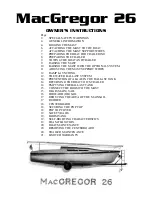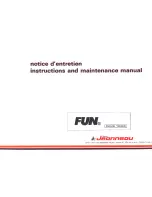
Section B
Page 6
378 Vista™ Owner’s Manual
™
378
F. Treatment (Evaluate, Ventilate, Evacuate, Inves-
tigate, Take Corrective Action)
1. Evaluate the situation and ventilate the area if pos-
sible.
2. Evacuate the area and move affected person(s) to
a fresh air environment.
3. Observe the victim(s).
4. Administer oxygen if available.
5. Contact medical help. If the victim is not breathing,
perform rescue breathing or approved cardiopul-
monary resuscitation (CPR), as appropriate, until
medical help arrives and takes over.
NOTICE
Prompt action can make the difference between
life and death.
6. Investigate source of CO and take corrective ac-
tion.
G. Inspection
Look and listen for leaks in the exhaust systems of both
the generator and propulsion engine(s). Look for discol-
oration around joints in the system (water leaks, carbon,
stains, etc.).
1. Make sure all exhaust clamps are in place and se-
cured.
2. Make sure ventilation systems work and are not ob-
structed or restricted.
3. Make sure gaps around the engine room plumbing
and cableways and exhaust system doors, hatches,
and access panels are minimized to reduce the op-
portunity for CO to enter the accommodation
space(s).
H. Operation
Cold Start vs. Warm Start: CO production is greater while
the combustion chamber surfaces and gas passages
are cold versus when they are warm. A boat operator
should:
1. Pay attention to ventilating the boat.
2. Orient the boat so it will allow the maximum dissipa-
tion of CO.
3. Minimize the time spent on getting underway.
4. In order to minimize CO buildup, do not warm up
or run propulsion engine(s) for extended periods
while the vessel is stationary.
The following are examples of possible situa-
tions where carbon monoxide can accumulate
within your boat while docked, anchored, or un-
derway. Become familiar with these examples
and their precautions to prevent
dangerous
accidents or death.
I.
Boathouses, Sea Walls and Confined Spaces
A boat operator should be aware that dangerous con-
centrations of CO can accumulate when a boat, genera-
tor or other engine operated device is operated while the
boat is moored in a confined area such as:
1. Boathouses,
2. Proximity to sea walls, or
3. Proximity to other boats.
Keep engine room hatches and doors closed when
operating engines, including the generator.
Pay attention to prevailing conditions and provide for
ventilation to induce fresh air and minimize exhaust re-
entry. Orient the boat for maximum dissipation of the
exhaust. DO NOT run the boat or boat equipment for
extended periods under these conditions. See Figure
B7.
Figure B7: The effect of sea walls and other confined spaces.
Содержание 378 VISTA
Страница 1: ...378 VISTA OWNERS MANUAL ...
Страница 51: ...Section C Page 7 378 Vista Owner s Manual 378 Figure C5 Navigational Aids Chart ...
Страница 72: ...Section G Page5 378 Vista Owner s Manual 378 Figure G5 378V Inboard Propulsion System NOT SHOWN ...
Страница 73: ...Section G Page6 378 Vista Owner s Manual 378 Figure G6 Tie Bar 47 1 4 Tiller Arm Assembly ...
Страница 162: ...Service Log Page 1 378 Vista Owner s Manual 378 SERVICE LOG E T A D S R U O H D E M R O F R E P E C N A N E T N I A M ...
Страница 163: ...Service Log Page 2 378 Vista Owner s Manual 378 SERVICE LOG E T A D S R U O H D E M R O F R E P E C N A N E T N I A M ...
Страница 164: ...Service Log Page 3 378 Vista Owner s Manual 378 SERVICE LOG E T A D S R U O H D E M R O F R E P E C N A N E T N I A M ...
Страница 166: ...Locator Drawing Page 1 378 378 VISTA LOCATOR DRAWING 378 Vista Owner s Manual ...
Страница 196: ... Page 30 CLARION AMPLIFIER APX400 4M CONNECTIONS SETTINGS Electrical Schematics ...
Страница 199: ......
Страница 200: ......
Страница 201: ...A G E N M A R C O M P A N Y P A R T 0 9 0 2 7 4 4 ...
















































